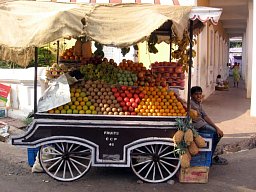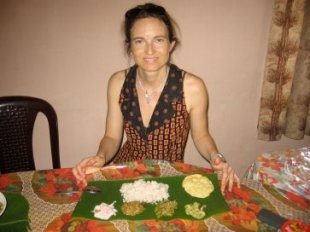
 How to Eat Healthy According to Ayurveda
How to Eat Healthy According to Ayurveda
Contrary to what you might think, eating Ayurvedic diet doesn't mean eating only legumes, rice and vegetables. Basic Ayurveda diet principles can be applied to any cuisine, be it Mediterranean, Asian, European, or whichever one you prefer.
“What we eat affects our emotions and can create a predisposition for both psychological and physical disorders. Just as wrong emotion can upset our digestion, so wrong digestion can upset our emotions.”
-Dr.David Frawley, Ayurvedic Healing
“You are what you eat” is a saying that you have probably heard before. It holds true not only on the physical but also on the psychological level. When you mostly eat hamburger and french fries, well, you probably feel like hamburger and french fries (not a very nice feeling).
The most important principle in the Ayurvedic Diet is that your food is fresh (without pesticides, additives and other chemicals), seasonal, and as often as possible local. Fresh doesn't, however, mean raw. The best are freshly cooked, whole meals.
Go to your local farmers' market once a week and buy what everybody seems to be selling (often the cheapest), because that is exactly what is in season (of course winter in Midwest is a different story, but this is when well preserved food becomes handy).
When you want to know how to eat healthy, this is a great start. Cook more with fresh produce and start playing with some basic Ayurvedic spices, such as turmeric, ginger, cumin and coriander. No matter what you cook, you can almost always add these spices to your dish. Not only are those excellent flavor and digestion enhancers, but they also have many medicinal properties.
The Importance of Six Tastes in Ayurvedic Diet
Ayurveda recognizes six tastes and it's quite important to have all of these 6 tastes in your diet every day. The six tastes are:
Sweet – sugar, honey, rice, pasta, milk, etc.
Sour – lemons, hard cheese, yogurt, vinegar, etc.
Salty – salt, any salty food
Pungent – chili peppers, cayenne, ginger, any hot spice
Bitter – leafy greens, turmeric, lettuce, etc.
Astringent – pomegranate, beans, lentils, etc.
These six tastes are listed in the order they are digested in your body. Sweet gets digested first, that's why it's not a good idea to have a dessert at the end of the meal, which is typical in our culture, but rather at the beginning (how is that for an Ayurvedic diet tip!). Salad, on the other hand, is perfect at the end of the meal. Ayurveda Diet has a very holistic-medicine-point of view on diet.
 Including all six tastes in your diet contributes to feeling satisfied at the end of a meal. Cravings are often caused by not having all of the six tastes in your daily diet. Many people often omit the bitter and astringent tastes (don't be one of them!). When you have something bitter or astringent at the end of a meal, it actually reduces your desire for sweets.
Including all six tastes in your diet contributes to feeling satisfied at the end of a meal. Cravings are often caused by not having all of the six tastes in your daily diet. Many people often omit the bitter and astringent tastes (don't be one of them!). When you have something bitter or astringent at the end of a meal, it actually reduces your desire for sweets.
Including all 6 tastes is a great way to incorporate Ayurvedic diet into your lifestyle and at the same time improve your health (not to mention a great way to shed off some pounds-effortlessly).
Concept of Agni in Ayurveda Diet
"Agni is the main source of life. Without agni, life is not possible."
-Dr.Vasant Lad, Textbook of Ayurveda
Agni, which translates as Fire (in our case Digestive Fire), is by many Ayurvedic physicians and practitioners, regarded as THE most important concept in Ayurvedic diet. When your Agni is healthy and strong, you can digest whatever you eat. On the other hand, when your digestive fire is weakened, you cannot digest the food you take and your body produces toxins. To balance your agni, follow the and try to eat lightly. is a great choice. You can also include a fresh ginger tea in your diet (just cut about 1/4 inch of fresh ginger, peel it and grate it; cover with hot water and let sit for 5 minutes; sip throughout the day).
How to Eat Out
The first (and often the most important) answer to how to eat out . . .
is always asking for room temperature or warm water instead of ice cold water. There is nothing that kills the digestive fire (agni) faster than an ice cold water on an empty stomach.
Keep the always in mind when you want to know how to eat out. Just by knowing which tastes & qualities are balancing for your Ayurveda Body Type, will help you to make the right decisions.
For example, for Vata, warm soup is a better choice than an ice cold salad (Vata gets balanced with warm quality and aggravated with cold). When eating out, stay away from raw, cold foods and focus on well cooked, warm dishes.
On the other hand, if you have a predominant Pitta dosha, you will do much better with raw food and often salad bars, as well as vegetarian dishes, are great option for you. Stay away from deep fried, garlicky and tomato dishes (anything hot/spicy aggravates Pitta).
If Kapha is your dominant dosha, you will do best with light choices, lightly steamed/cooked veggies, as well as light vegetarian dishes, are a great choice for you. Stay away from dishes that are heavy/oily, with lots of cheese, sour cream and that are fried.
RELATED VIDEO












